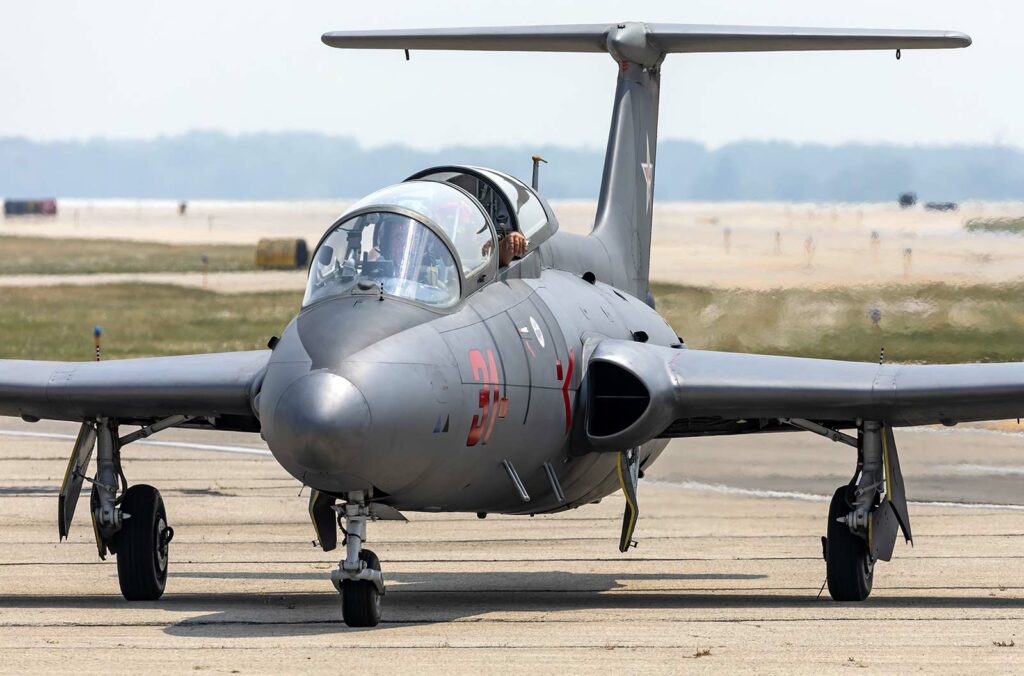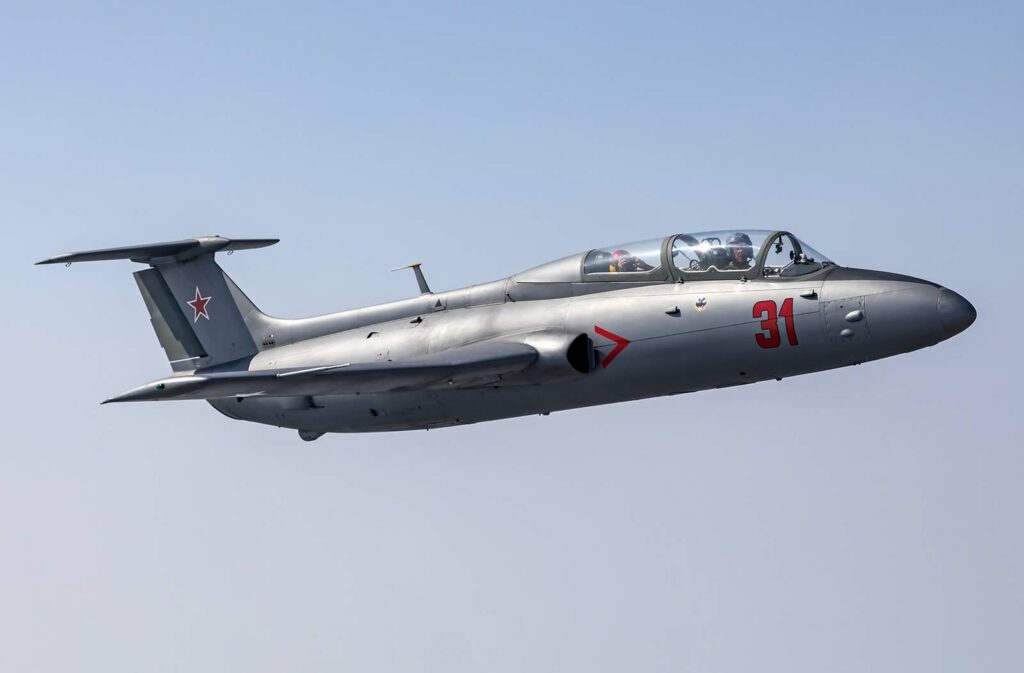The Aero L-29 Delfín is a Czechoslovakian jet trainer, known for its robust design, serving as the Warsaw Pact’s primary training aircraft.
In Brief
The Aero L-29 Delfín, a two-seat, single-engine jet trainer initially designed in the late 1950s, became the standard trainer for Warsaw Pact air forces. It features a straightforward, durable design with a tricycle landing gear and a turbojet engine mounted in the fuselage’s rear, exhausting under the tailplane. The aircraft’s simplicity, reliability, and cost-effectiveness made it popular in numerous countries, evidenced by over 3,000 units produced. It was utilized for basic, advanced, and weapons training, demonstrating its versatility and adaptability to various training missions.

History of the Development of the Aero L-29 Delfín
The Aero L-29 Delfín, also known as “Maya” in NATO terminology, symbolizes a significant era in aviation history, marking the progression of jet training aircraft during the Cold War. Its inception was driven by the necessity for a standardized jet trainer across the Warsaw Pact nations to ensure uniform pilot training and operational capability. The Czechoslovak aircraft manufacturer Aero Vodochody launched the L-29 program in response to this requirement.
The development began in the late 1950s, amidst a period where the aviation world was rapidly transitioning from propeller-driven to jet-powered aircraft. This shift necessitated a new breed of trainer aircraft that could adequately prepare pilots for the demands of flying high-speed jets. The Soviet Union, seeking to streamline its satellite states’ military training programs, initiated a competition to select a standard jet trainer.
Aero Vodochody’s L-29 was a direct response to this call. The aircraft first took to the skies on April 5, 1960, showcasing its potential to meet the diverse training requirements of the Warsaw Pact air forces. Its design was a blend of simplicity, durability, and efficiency, attributes that were crucial for a training aircraft expected to operate in varied and often challenging conditions.
The L-29’s selection as the standard training aircraft for the Warsaw Pact was not just a testament to its capabilities but also a strategic move to enhance the interoperability among the member states’ air forces. The nickname “Maya,” assigned by NATO, reflects the aircraft’s prominence in the military aviation circles of the time, representing a significant step forward in pilot training methodology and military cooperation within the Eastern Bloc.
Design of the Aero L-29 Delfín
The Aero L-29 Delfín was meticulously designed to fulfill the rigorous demands of a jet training aircraft. Its airframe features a conventional monocoque structure, crafted predominantly from aluminum alloys, ensuring a lightweight yet sturdy build. The aircraft is powered by a Motorlet M-701 turbojet engine, positioned in the rear fuselage, with an air intake located at the root of each wing and an exhaust under the tailplane, a configuration that contributes to its streamlined profile and operational efficiency.
The L-29 boasts a wingspan of 33 feet (10.29 meters) and a length of 35 feet 5 inches (10.8 meters), dimensions that provide optimal balance and maneuverability essential for training purposes. The cockpit is designed for a crew of two — an instructor and a trainee — equipped with ejection seats and a clear canopy that offers excellent visibility, a critical feature for training aircraft.
One of the significant advantages of the L-29’s design was its simplicity and reliability, which translated into lower maintenance costs and easier operational management. However, its straightforward design also meant it lacked the advanced avionics and systems found in more contemporary trainers. Nevertheless, it brought a significant advantage to the training realm, providing a realistic yet manageable platform for pilots transitioning to high-performance jets.
Performance of the Aero L-29 Delfín
The L-29 Delfín’s performance characteristics were well-suited to its role as a training aircraft. The Motorlet M-701 engine, delivering 1,960 pounds of thrust (8.7 kN), enabled a maximum speed of 407 miles per hour (655 km/h) and a service ceiling of 33,000 feet (10,000 meters). Its range extended up to 550 miles (885 kilometers), sufficient for extended training missions or light transport duties.
Comparatively, the L-29 was not the most powerful aircraft of its era, especially when compared to frontline fighters. However, its performance was ideally tuned to the training environment, providing a balanced mix of speed, agility, and safety. It allowed trainees to experience jet flight in a controlled, responsive aircraft that could simulate the characteristics of more advanced fighters they might later operate.
Variants of the Aero L-29 Delfín
The L-29 Delfín was produced in several variants, each designed to fulfill different roles or improve upon the base model. The primary version was the L-29 standard trainer, but notable variants included the L-29R, a reconnaissance version equipped with cameras and additional radio equipment, and the L-29A Akrobat, a single-seat aerobatic version. Another significant variant was the L-29RS, designed for advanced training and light attack, capable of carrying weapons on underwing pylons.
Each variant maintained the core attributes of reliability and ease of maintenance while expanding the aircraft’s versatility. The differences in specifications among the variants were generally minor but targeted specific operational needs, from enhanced photographic reconnaissance capabilities to improved aerobatic performance.
Military Use and Combat of the Aero L-29 Delfín
The Aero L-29 Delfín’s military significance extended beyond its primary training role. It was equipped with hardpoints allowing it to carry a range of armaments, including bombs, rockets, and gun pods, enabling it to serve in light attack roles. This adaptability was particularly valuable in conflict zones where flexible air support was crucial.
Throughout its service life, the L-29 saw combat in various conflicts. It was used extensively during the Nigerian Civil War, where its simplicity and robustness were highly valued in the challenging operational environment. Its combat roles ranged from ground attack missions to reconnaissance and even limited air-to-air combat, demonstrating its versatility and reliability in combat situations.
The L-29 competed with various Western trainers like the Cessna T-37 Tweet and the British BAC Jet Provost. While these aircraft were comparable in performance, the L-29’s ruggedness, ease of maintenance, and lower operating costs made it a preferred choice for many air forces, especially those aligned with or supported by the Soviet Union.
The aircraft was exported widely, serving in over 25 countries across four continents. Its international service record underscores its adaptability to different climates and operational conditions. Although largely phased out of active service, replaced by more modern trainers like the Aero L-39 Albatros, some L-29s continue to fly in civilian hands, cherished for their historical significance and flying characteristics.

The Aero L-29 Delfín stands out in aviation history as a robust, versatile, and effective training aircraft that bridged the gap between propeller-driven trainers and the jet fighters of the Cold War era. Its design, performance, and operational history reflect its pivotal role in preparing generations of pilots, showcasing the enduring legacy of this iconic aircraft.
Back to the Fighter Jet section.